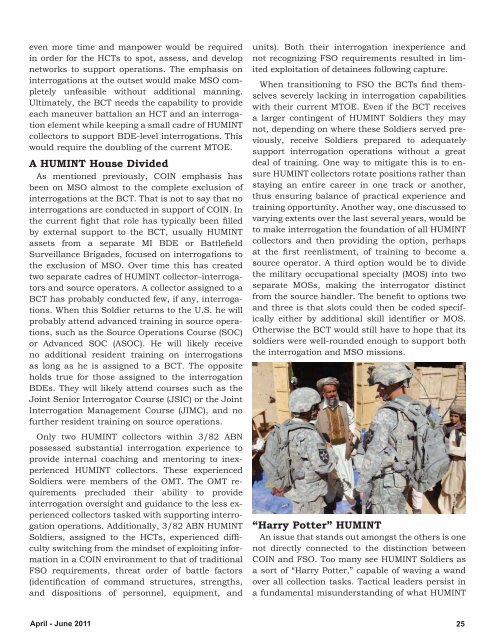George w. casey jr. - Federation of American Scientists
George w. casey jr. - Federation of American Scientists
George w. casey jr. - Federation of American Scientists
Create successful ePaper yourself
Turn your PDF publications into a flip-book with our unique Google optimized e-Paper software.
even more time and manpower would be required<br />
in order for the HCTs to spot, assess, and develop<br />
networks to support operations. The emphasis on<br />
interrogations at the outset would make MSO completely<br />
unfeasible without additional manning.<br />
Ultimately, the BCT needs the capability to provide<br />
each maneuver battalion an HCT and an interrogation<br />
element while keeping a small cadre <strong>of</strong> HUMINT<br />
collectors to support BDE-level interrogations. This<br />
would require the doubling <strong>of</strong> the current MTOE.<br />
A HUMINT House Divided<br />
As mentioned previously, COIN emphasis has<br />
been on MSO almost to the complete exclusion <strong>of</strong><br />
interrogations at the BCT. That is not to say that no<br />
interrogations are conducted in support <strong>of</strong> COIN. In<br />
the current fight that role has typically been filled<br />
by external support to the BCT, usually HUMINT<br />
assets from a separate MI BDE or Battlefield<br />
Surveillance Brigades, focused on interrogations to<br />
the exclusion <strong>of</strong> MSO. Over time this has created<br />
two separate cadres <strong>of</strong> HUMINT collector–interrogators<br />
and source operators. A collector assigned to a<br />
BCT has probably conducted few, if any, interrogations.<br />
When this Soldier returns to the U.S. he will<br />
probably attend advanced training in source operations,<br />
such as the Source Operations Course (SOC)<br />
or Advanced SOC (ASOC). He will likely receive<br />
no additional resident training on interrogations<br />
as long as he is assigned to a BCT. The opposite<br />
holds true for those assigned to the interrogation<br />
BDEs. They will likely attend courses such as the<br />
Joint Senior Interrogator Course (JSIC) or the Joint<br />
Interrogation Management Course (JIMC), and no<br />
further resident training on source operations.<br />
Only two HUMINT collectors within 3/82 ABN<br />
possessed substantial interrogation experience to<br />
provide internal coaching and mentoring to inexperienced<br />
HUMINT collectors. These experienced<br />
Soldiers were members <strong>of</strong> the OMT. The OMT requirements<br />
precluded their ability to provide<br />
interrogation oversight and guidance to the less experienced<br />
collectors tasked with supporting interrogation<br />
operations. Additionally, 3/82 ABN HUMINT<br />
Soldiers, assigned to the HCTs, experienced difficulty<br />
switching from the mindset <strong>of</strong> exploiting information<br />
in a COIN environment to that <strong>of</strong> traditional<br />
FSO requirements, threat order <strong>of</strong> battle factors<br />
(identification <strong>of</strong> command structures, strengths,<br />
and dispositions <strong>of</strong> personnel, equipment, and<br />
units). Both their interrogation inexperience and<br />
not recognizing FSO requirements resulted in limited<br />
exploitation <strong>of</strong> detainees following capture.<br />
When transitioning to FSO the BCTs find themselves<br />
severely lacking in interrogation capabilities<br />
with their current MTOE. Even if the BCT receives<br />
a larger contingent <strong>of</strong> HUMINT Soldiers they may<br />
not, depending on where these Soldiers served previously,<br />
receive Soldiers prepared to adequately<br />
support interrogation operations without a great<br />
deal <strong>of</strong> training. One way to mitigate this is to ensure<br />
HUMINT collectors rotate positions rather than<br />
staying an entire career in one track or another,<br />
thus ensuring balance <strong>of</strong> practical experience and<br />
training opportunity. Another way, one discussed to<br />
varying extents over the last several years, would be<br />
to make interrogation the foundation <strong>of</strong> all HUMINT<br />
collectors and then providing the option, perhaps<br />
at the first reenlistment, <strong>of</strong> training to become a<br />
source operator. A third option would be to divide<br />
the military occupational specialty (MOS) into two<br />
separate MOSs, making the interrogator distinct<br />
from the source handler. The benefit to options two<br />
and three is that slots could then be coded specifically<br />
either by additional skill identifier or MOS.<br />
Otherwise the BCT would still have to hope that its<br />
soldiers were well-rounded enough to support both<br />
the interrogation and MSO missions.<br />
“Harry Potter” HUMINT<br />
An issue that stands out amongst the others is one<br />
not directly connected to the distinction between<br />
COIN and FSO. Too many see HUMINT Soldiers as<br />
a sort <strong>of</strong> “Harry Potter,” capable <strong>of</strong> waving a wand<br />
over all collection tasks. Tactical leaders persist in<br />
a fundamental misunderstanding <strong>of</strong> what HUMINT<br />
April - June 2011 25















